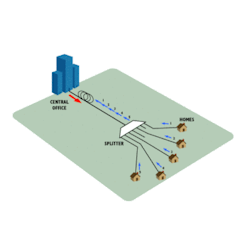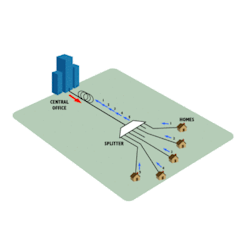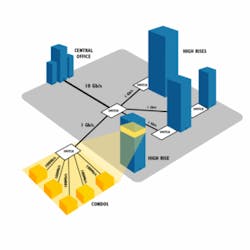Debating the merits of PONs vs. Ethernet for high-density residential networks
While PONs have their place, switched Ethernet may be the best option for high-density population centers.
Frank Levinson, PhD
Finisar Corp.
One of the current debates in the field of optical networking has to do with so-called passive optical networks (PONs). Some companies in our industry promote PONs for multi-tenant residences and dense urban areas. Are they touting their technologies at the expense of practicality and efficient network design? Is there a better way to deliver high-bandwidth network services to high-density residential areas?
PON fundamentals
A PON is a network designed for low-cost delivery of high-bandwidth services to individual households. It relies on the sharing of fiber plant and central office (CO) resources that typically use either SONET or Ethernet protocols.
Figure 1 provides a simple diagram that illustrates the key characteristics of a PON. The network has a single, high-power optical transceiver at the CO that sends a single wavelength (or two, if the network supports RF video as described below) to end users and homes. Near those homes, this light signal passes through a splitter and the signal is simultaneously shared or broadcast to all users. As the light splits down multiple paths, it loses much of its intensity. This means that the receivers in the homes must be very sensitive to accurately receive the CO's transmission.
The same fiber that delivers light signals into each of the homes is also used to send light back from the homes. This requires relatively bright lasers and sensitive receivers and also requires something more. Each house has its own individual transmitter, and outgoing signals on the outbound path or "reverse path" must be coordinated so that only one transmitter is sending at any given time. Homes are scheduled to send their signals in such a way that they can share a single fiber.
This type of sharing puts extra demands on the receiver in the CO. Each reverse signal can be different in power or intensity, and each signal arrives slightly out of phase with respect to other transmissions sent from the other homes.
A key point in PON architecture is bandwidth for a particular set of users is shared under nearly all conditions. This shared bandwidth does not scale over time as it does in a switched network, but it may be possible to add additional wavelengths to the original ones and add higher-speed signals on these new wavelengths.
New PON architecture going into trial this year actually uses three wavelengths. Two wavelengths go towards the house -- one is analog (meaning that the light is not sending 1s and 0s but is modulated to different levels over time representing many different television or audio channels) and carries CATV-like video, while the other is for digital IP services and runs at 622 Mbits/sec. The reverse wavelength sends data at 155 Mbits/sec. These latter two bandwidths are shared among up to 32 users. The reverse path typically offers each user 2 or 3 Mbits/sec when the inefficiencies of the reverse path are fully considered.
Why are PONs all the rage today?
PONs are particularly cost-effective in delivering bandwidth to households in areas of low population density, such as suburban neighborhoods where a single family home may be sited on some fraction of an acre of land. Such homes are commonly found in the USA and Canada. But in Europe and Asia, population density is significantly higher.
A combination of optical and electrical Ethernet is an alternative option for constructing networks for high-density residential areas (see Figure 2). First, deliver optical 10-Gbit/sec Ethernet to neighborhoods, then optical 1-Gbit/sec Ethernet to high-rise buildings and building complexes, and then electrical (copper media/Cat 5 wire) 100-Mbit/sec service to each condo or apartment. The cost of doing this is much less expensive than a PON system. The delivered bandwidth starts at 100 Mbits/sec, which is impressively high for a residence. Using this same architecture, it's even possible to deliver 1-Gbit/sec Ethernet to residential end users over copper or optical fibers.
In many residences, this very high bandwidth is not absolutely required, but it is useful in making the end-user experience more productive and enjoyable. Consider the following examples.
- If you download a movie using DSL and attain an average speed of 1 Mbit/sec, it will take three to five hours to receive the movie. But if you have 100-Mbit/sec service, receiving the entire movie will take only a minute or two.
- Home office workers want an experience similar in every way to what they have at the company office. This requires sufficient bandwidth to access large files, participate in the corporate phone and video conferencing networks, interactively share files, and collaborate using Web facilities -- and people will want to do all of this simultaneously.
- Educational interaction will continue to rise along with video game technology. One is related to the other. And both will be increasingly bandwidth demanding, especially as the content contains more video and interactivity.
- Finally, as all members of a household become computer and network literate, all of them will want to do all of this at the same time. Recent DSL advertisements tout the availability of a wireless router "free" when you sign up for the service, and it is precisely this approach that empowers simultaneous use of the DSL connection by all family members.
Switched Ethernet is the very best way to deliver Internet Protocol (IP) services directly to residential customers in dense areas. PONs are less cost-efficient than traditional Ethernet switches and Ethernet technology running directly from the source to the end user.
Switched Ethernet delivers more bandwidth to the edge of the network. All of this bandwidth can be delivered to a single point or can be shared. Switched Ethernet has the additional advantage of providing the same bandwidth in both directions. Every customer can receive all the bandwidth they need and every node receives service from a single pipe and protocol. In general, the users' need for bandwidth is very lumpy or bursty. When they want it they want a lot of it, and when they do not, they need virtually nothing. It is precisely this utilization pattern that makes a pure Ethernet and IP approach attractive.
Switched Ethernet is a simple and elegant solution for high-density communities. It is the very best way to embrace a well-networked future, and a better choice than a PON in the situations described above.
Frank Levinson, PhD ([email protected]) is founder, CTO, and chairman of Finisar Corp. (Sunnyvale, CA).

